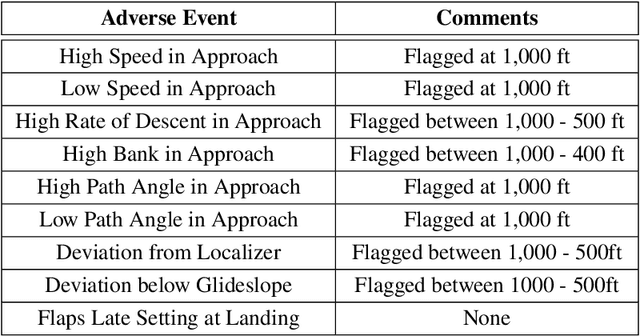Bryan Matthews
Multi-Class Multiple Instance Learning for Predicting Precursors to Aviation Safety Events
Mar 10, 2021



Abstract:In recent years, there has been a rapid growth in the application of machine learning techniques that leverage aviation data collected from commercial airline operations to improve safety. Anomaly detection and predictive maintenance have been the main targets for machine learning applications. However, this paper focuses on the identification of precursors, which is a relatively newer application. Precursors are events correlated with adverse events that happen prior to the adverse event itself. Therefore, precursor mining provides many benefits including understanding the reasons behind a safety incident and the ability to identify signatures, which can be tracked throughout a flight to alert the operators of the potential for an adverse event in the future. This work proposes using the multiple-instance learning (MIL) framework, a weakly supervised learning task, combined with carefully designed binary classifier leveraging a Multi-Head Convolutional Neural Network-Recurrent Neural Network (MHCNN-RNN) architecture. Multi-class classifiers are then created and compared, enabling the prediction of different adverse events for any given flight by combining binary classifiers, and by modifying the MHCNN-RNN to handle multiple outputs. Results obtained showed that the multiple binary classifiers perform better and are able to accurately forecast high speed and high path angle events during the approach phase. Multiple binary classifiers are also capable of determining the aircraft's parameters that are correlated to these events. The identified parameters can be considered precursors to the events and may be studied/tracked further to prevent these events in the future.
Semi-Markov Switching Vector Autoregressive Model-based Anomaly Detection in Aviation Systems
Feb 28, 2016



Abstract:In this work we consider the problem of anomaly detection in heterogeneous, multivariate, variable-length time series datasets. Our focus is on the aviation safety domain, where data objects are flights and time series are sensor readings and pilot switches. In this context the goal is to detect anomalous flight segments, due to mechanical, environmental, or human factors in order to identifying operationally significant events and provide insights into the flight operations and highlight otherwise unavailable potential safety risks and precursors to accidents. For this purpose, we propose a framework which represents each flight using a semi-Markov switching vector autoregressive (SMS-VAR) model. Detection of anomalies is then based on measuring dissimilarities between the model's prediction and data observation. The framework is scalable, due to the inherent parallel nature of most computations, and can be used to perform online anomaly detection. Extensive experimental results on simulated and real datasets illustrate that the framework can detect various types of anomalies along with the key parameters involved.
 Add to Chrome
Add to Chrome Add to Firefox
Add to Firefox Add to Edge
Add to Edge